The rules for a yellow card in soccer are very much debated and can be a matter of opinion. Let’s look at the rules to see what they say.
Before we examine the official FIFA rules about yellow cards in soccer, let’s look at some common questions people have. This is Important!
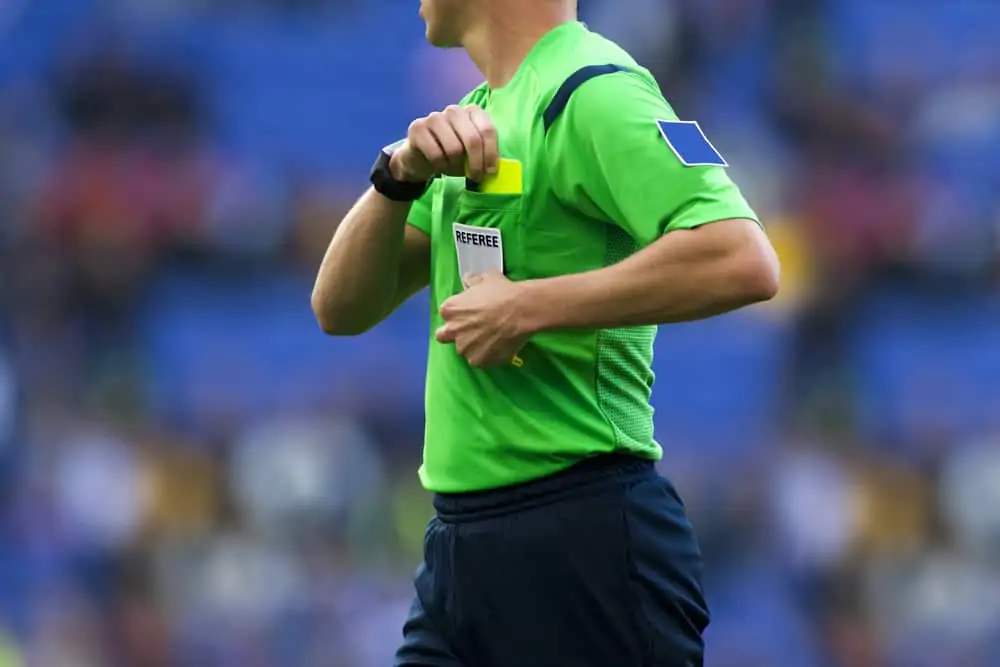
- What is a yellow card in soccer?
- What Do You Get For A Yellow Card?
- How many yellow cards can you get in soccer?
- How long does a yellow card last in soccer?
- What Happens if you get Two Yellow Cards?
- What are the offenses for a yellow card in the MLS?
- English FA yellow card rules
- What do refs write on yellow cards?
- Yellow Cards in Soccer: The Official FIFA Rules
- List of Offenses/fouls a player can make for a yellow card
- Seven Yellow Card Offenses for a Player: Misconduct
- Other Offences for a Yellow Card
What is a yellow card in soccer?
A yellow card is given as a caution when a player is reckless, careless, misconduct, or uses excessive force.
This applies to players, substitutes, or substituted players.
What Do You Get For A Yellow Card?
A yellow card can result in a suspension, sending off, a fine, and disciplinary action.
The number of yellow cards and the offense will determine the action, and it’s different for each competition.
How many yellow cards can you get in soccer?
In soccer, you can only get two yellow cards in one game. If you get two yellow cards for reckless or unsporting behavior, it results in a red card, and the player is sent off the field.
Normally, when a player gets the first yellow card, they will not slide into tackles and be more cautious to prevent being sent off.
Some officials will give you the warning to tell you that you’re one bad tackle away from another yellow card.
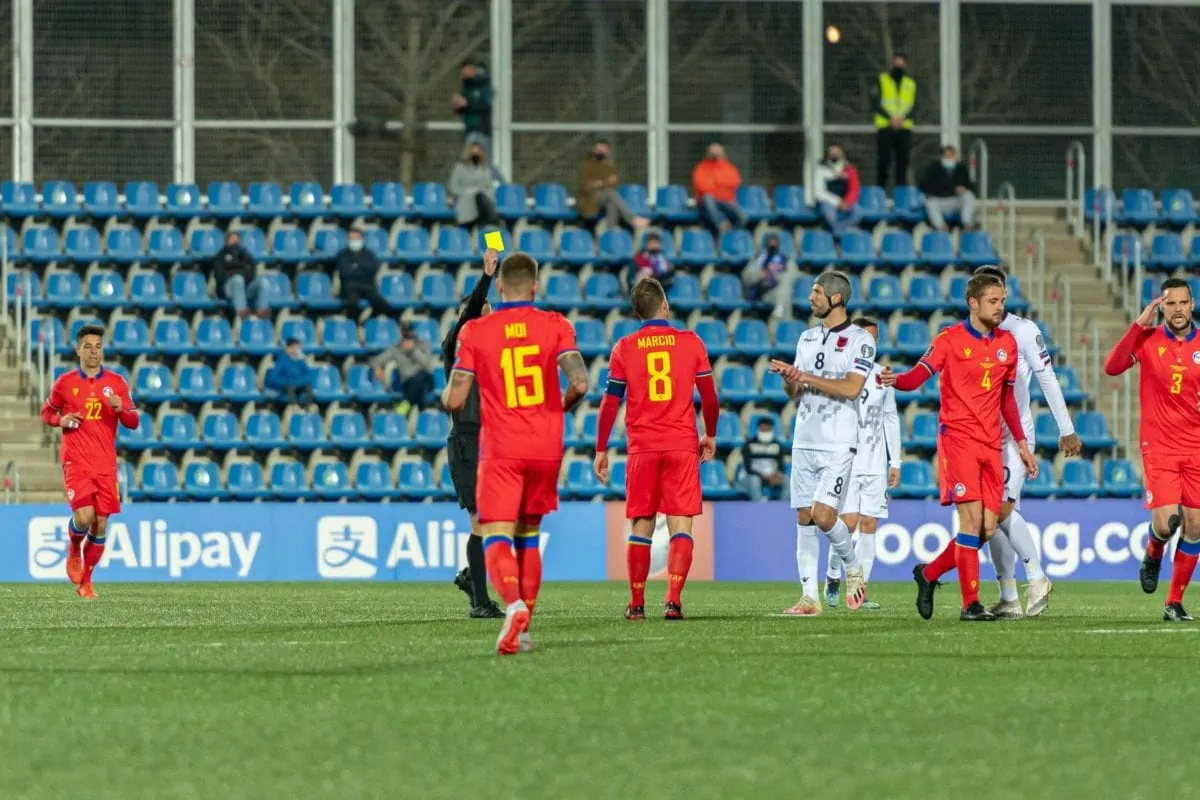
How long does a yellow card last in soccer?
A yellow card remains with the player for the rest of the game. The caution will also be added to the player’s record, which can amount to a suspension.
Different competitions have different policies for suspensions. They also include a set time when the yellow cards are wiped off the player’s record.
The record of yellow cards per season is removed from a player halfway through the season in the EPL. Yellow cards are also reset in the European Champions League knockout stages.
In the EPL, if a player gets 5 yellow cards in 19 games, the player will be suspended for one game.
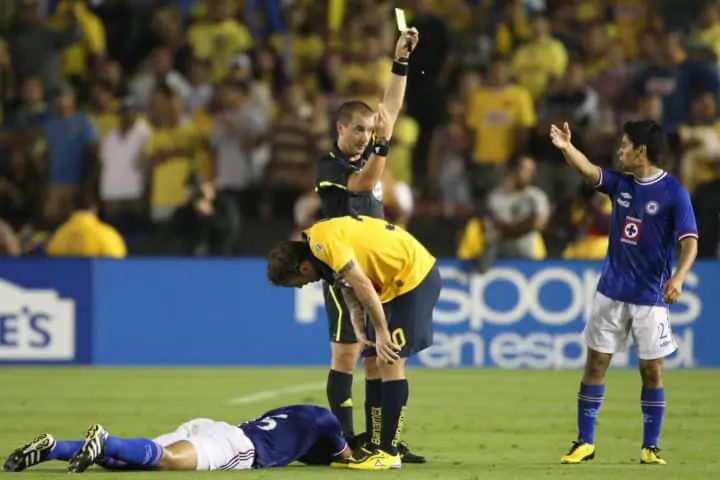
What Happens if you get Two Yellow Cards?
If two cards are given to a player during a match, it will result in a red card. While the game is stopped, the player will be told to leave the field.
The game cannot continue until the player is away from the referee’s sight. The player will return to the dressing room in a professional game.
In a non-professional league that doesn’t have a stadium, the player needs to be a respectful distance away from the action so they are not a distraction to the officials or players.
What are the offenses for a yellow card in the MLS?
If an MLS player gets 5 yellow cards or more, they are suspended and fined.
The MLS has its own rules for players who are given yellow cards. The official fines and suspensions for players are as below;
Fines and suspensions for MLS players for yellow cards
- 5 yellow cards suspension for 1 MLS game and fined $250.
- 8 yellow cards suspension for 1 MLS game and fined $500.
- 11 yellow cards suspension for 1 MLS game and fined $750.
- 13 yellow cards suspension for 1 MLS game and fined $1000.
- Additional to the above, plus 2 more yellow cards the player will be suspended and the fine will be doubled – eg. $2000, $4000, and $8000.
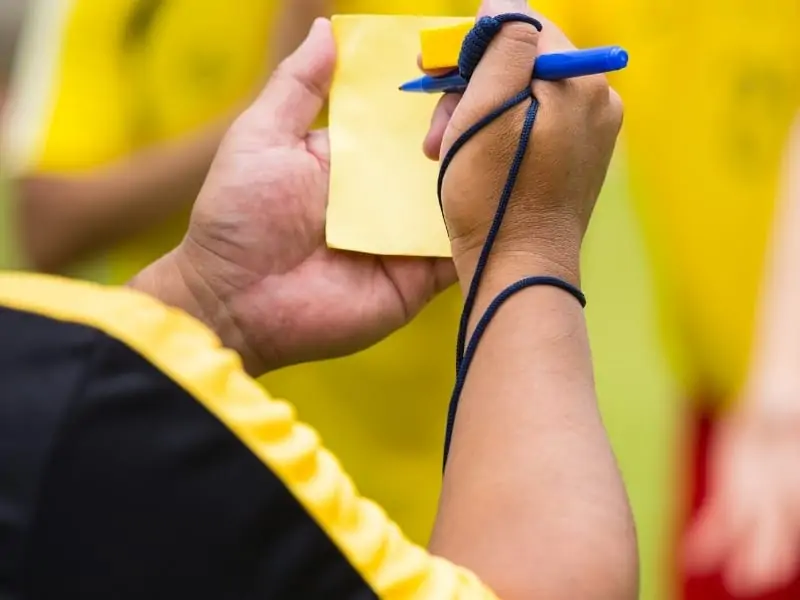
English FA yellow card rules
The English FA has a list of rules for yellow cards and fines for grassroots players in the game of soccer to promote discipline.
There are similar rules around the world for players below the professional leagues. It’s a great way to keep soccer from being a bad example.
| Charge Code | Offense | Fine | Automatic Suspension | Penalty Points |
| C1 | Unsporting Behaviour – further defined as: AA Adopting an aggressive attitude DI Simulation DP Dangerous Play FT Foul Tackle GC Goal Celebration HB Handball RP Reckless Play SP Pushing or Pulling an opponent TR Tripping UB Unspecified Behaviour | £10 | N/A | 1 |
| C2 | Dissent | £10 | N/A | 2 |
| C2 (sin bin) | Dissent (sin bin) | N/A | N/A | 2 |
| C3 | Persistently infringing the Laws of the Game | £10 | N/A | 1 |
| C4 | Delays the restart of play | £10 | N/A | 1 |
| C5 | Fails to respect the required distance at a restart | £10 | N/A | 1 |
| C6 | Enters or re-enters the field of play without the referee’s permission | £10 | N/A | 1 |
| C7 | Deliberately leaves the field of play without the referee’s permission | £10 | N/A | 1 |
| S1 | Serious Foul Play | £55 | 3 matches | 5 |
| S2 | Violent Conduct – further defined as: Head to Head Elbowing Kicking Stamping Striking Biting Other Unspecified Behaviour | £55 | 3 matches | 6 |
| S3 | Spitting | £55 | 6 matches | 7 |
| S4 | Denies the opposing team a goal or an obvious goal-scoring opportunity by deliberately handling the ball | £35 | 1 match | 3 |
| S5 | Denies an obvious goal-scoring opportunity to an opponent moving towards the player’s goal by an offence punishable by a free kick or a penalty kick | £35 | 1 match | 3 |
| S6 | Use of offensive, insulting or abusive language | £45 | 2 matches | 4 |
| S7 | Receives a second yellow card in the same match | £35 | 1 match | 3 |
What do refs write on yellow cards?
The ref writes the player’s number and team on the back of the card. This is a record of the offense so that the ref knows later in the game if the player gets another yellow.
The offense is also written on the card so the official can write the match report at the end of the game.
The match report is sent to the league regulators to register the offenses.
There have been occasions in the past where the ref has forgotten who was booked – the opposition is quick to remind the ref of this.
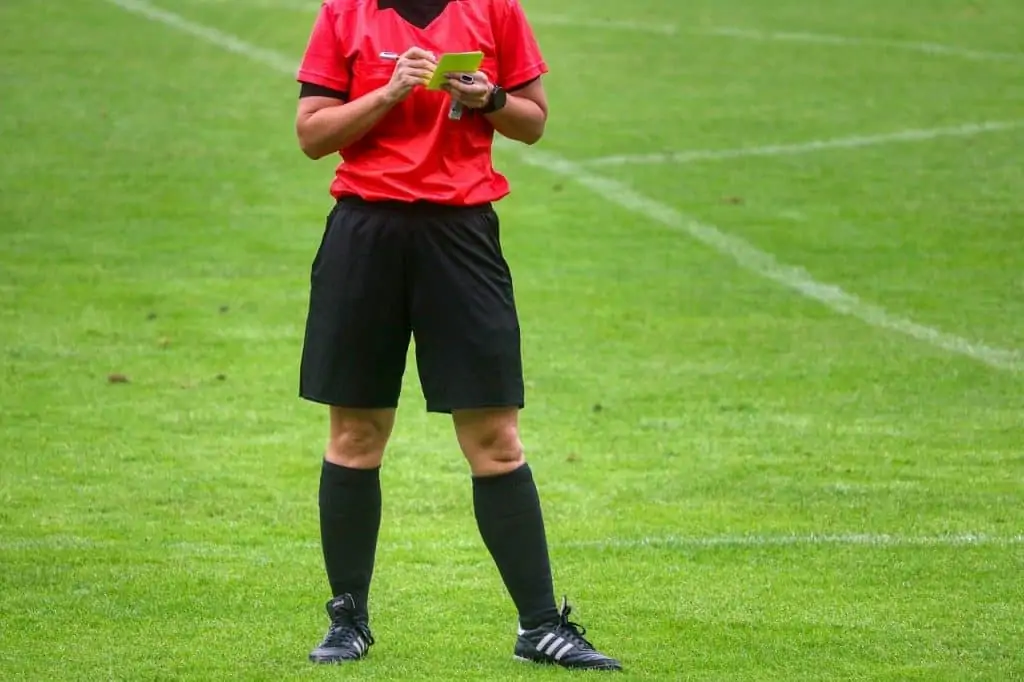
Yellow Cards in Soccer: The Official FIFA Rules
In this article, I have researched the rules from the officials at FIFA so that there is no debate, although some rules are at the referee’s discretion.
To keep it simple, all examples here are about yellow cards. There are several other rules regarding non-caution offenses and more for red cards.
type of fouls for a yellow card
The definition from FIFA about the types of fouls;
Carless – means that the player has shown a lack of attention or consideration when making his challenge or that he/she acted without precaution: no further disciplinary sanction is needed if a foul is judged to be careless.
FIFA Law 12
Reckless – means that the player has acted with complete disregard of the danger to, or consequences for, his opponent: a player who plays in a reckless manner shall be cautioned.
FIFA Law 12
Using excessive force – means that the player has far exceeded the necessary use of force and is in danger of injuring an on opponent: a player who uses excessive force shall be sent off
FIFA Law 12
For the following examples, we will need to use these three definitions – ‘carless’ ‘reckless’ and ‘using excessive force’. A yellow card is for;
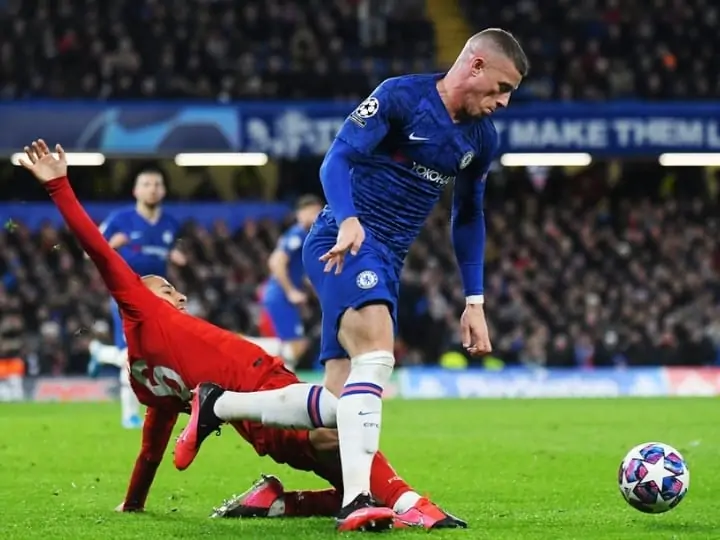
List of Offenses/fouls a player can make for a yellow card
- Charging an opponent – caution if reckless.
- Holding an opponent – When the ball is in play and the holding continues.
- Handling the Ball – When a player handles the ball to break up attacking play. If an attacker uses their hand to attempt to score a goal.
- Dangerous play – If a player makes an action that can risk an injury to another player.
- Impeding the progress of an opponent – If a player holds another player back or blocks a player on purpose, that prevents an attack.
- Breaking up an attack, where there is the possibility of creating a scoring chance.
- Simulation, where a player tries to con a referee into thinking that they are injured in order to punish the opponent. If a player tries to make out that they have been fouled. #
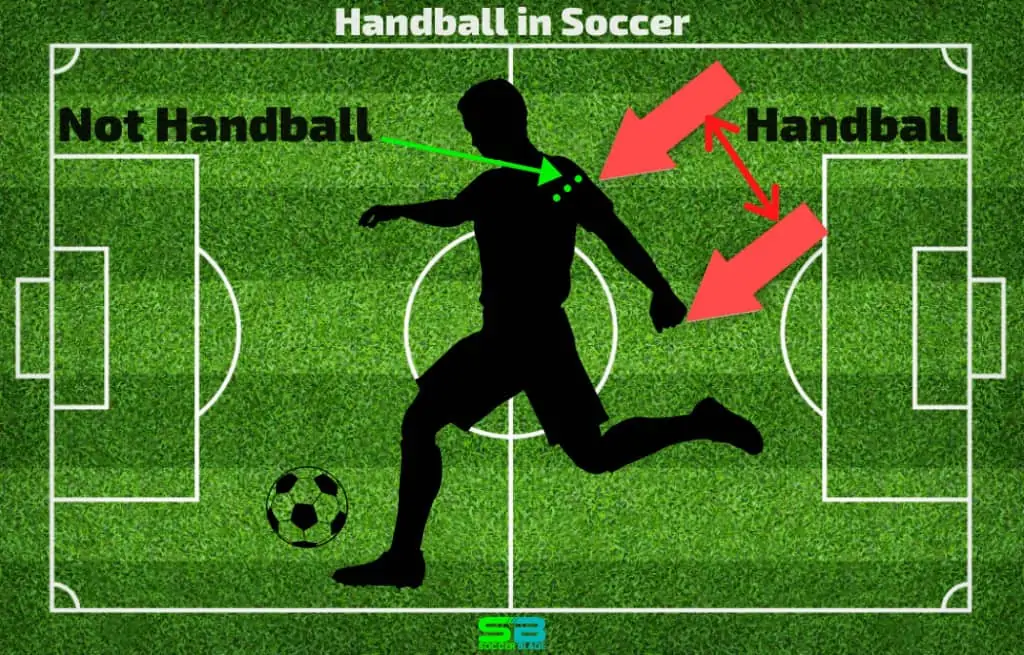
Seven Yellow Card Offenses for a Player: Misconduct
1. Reckless play or foul
If you play recklessly or commit a reckless foul, it’s a yellow card in soccer. This could be a high foot – without trying to hurt someone – or a sliding tackle from behind deliberately.
Referees will judge what reckless play or foul is. And it’s up to them to issue a yellow card.
2. Delaying the restart of play
Delaying the restart of play is a yellow card. That means you’re deliberately stopping the play from restarting.
It’s a yellow card if you kick the ball away. Or if you delay taking a free kick to waste time.
Also, a goalie can get a yellow card if they delay taking a goal kick. And if they hold onto the ball for too long in their 18-yard box to waste time, that can be a yellow card.
Referees can give a yellow card for any offense that delays play.
Here are the ways that players try to delay a restart in play;
- Deliberately taking a free kick from the wrong position
- Pretending to take a throw-in, only to leave it for another player
- Kicking or carrying the ball away when the referee has signaled to stop
- Excessively delaying taking a throw-in or set-piece
- Provoking an opponent by touching the ball to distract them
- Obstructing a set piece from being taken by standing in the way of the ball and not retreating
If a player tries to block the keeper when kicking it out of their hands, they receive a yellow card.
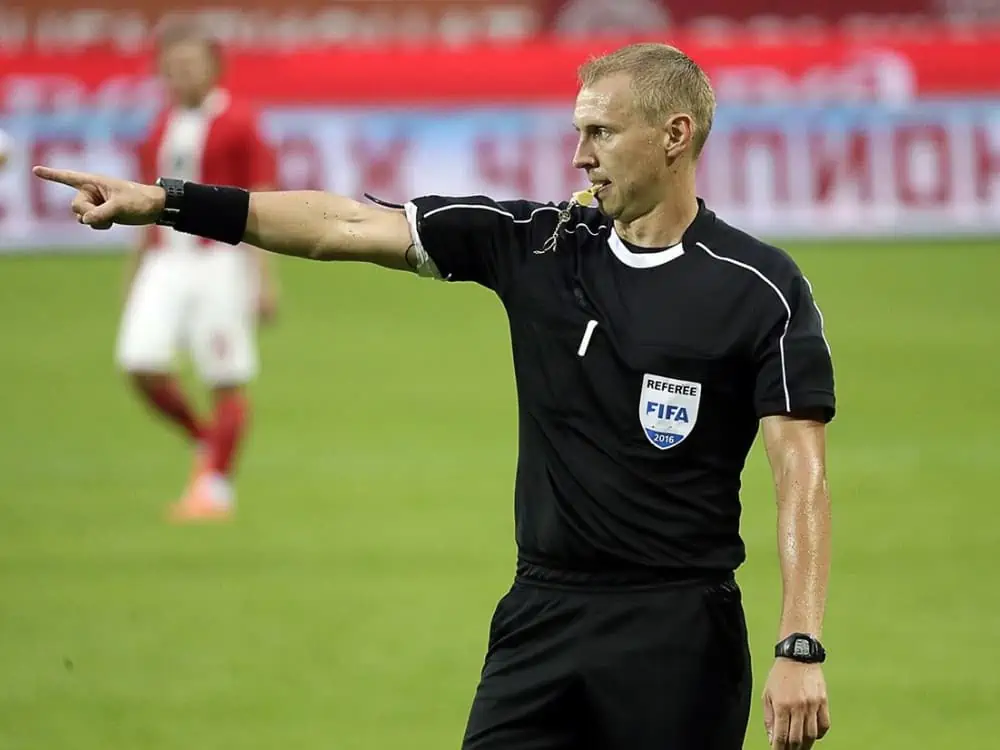
3. Dissent – language or behavior
In soccer, you can get a yellow card for dissent. This means going against the referee.
Protesting verbally or physically against the decision of a referee.
Dissenting language can be disrespectfully protesting the referee. Or it could be insulting the referee.
Dissenting behavior could be kicking/throwing the ball away because you don’t like a referee’s decision.
These offenses are yellow cards.
If a player tries to stop a goal from being scored – this can also result in a yellow card if the play is allowed to be continued by the referee and a goal is scored.
The referee can caution the player when the game is next stopped.
4. Not keeping distance from a free-kick, corner, or throw-in
If you don’t keep your distance from a free-kick, corner, or throw-in, it’s a yellow card. The referee might warn you to move back if you’re too close.
But if you ignore him and don’t move away, it’ll be a yellow card.
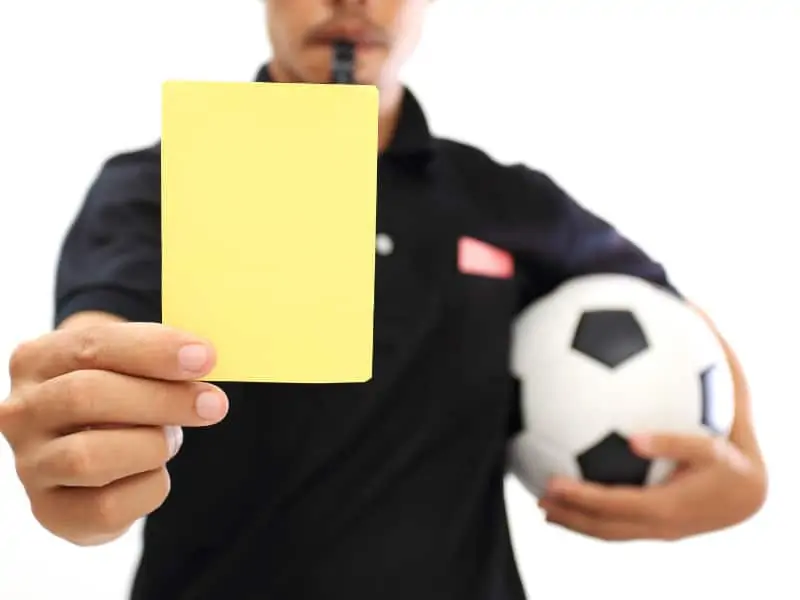
5. Exiting or entering the field of play without permission
In soccer, you shouldn’t leave the field or enter it during a game without the referee’s permission.
You might have to leave the field to get treatment for an injury or change a ripped jersey, for example. But you need to get permission.
Also, once you leave the field, you can’t come back on until the referee says it’s OK.
It’s a yellow card if you exit or enter the field of play without the referee’s permission.
That’s important to know because you don’t want a yellow card for a stupid reason.
6. Persistent minor offenses
Committing persistent minor offenses will get you a yellow card in soccer. You might commit a foul that doesn’t deserve a yellow card. But if you keep doing it, you’ll finally get one.
Say you commit 3 minor fouls in a short time. The referee will likely give you a warning. And then, if you foul again, they’ll give you a yellow card.
So, keep in mind that the minor fouls add up. The referee will be watching.
If a player commits several fouls throughout the game, regardless if they are the same.
A player will be warned by the referee when they have committed several fouls before being given a yellow card.
The discretion for this is for the referee to decide if a player commits several fouls within 15 minutes.
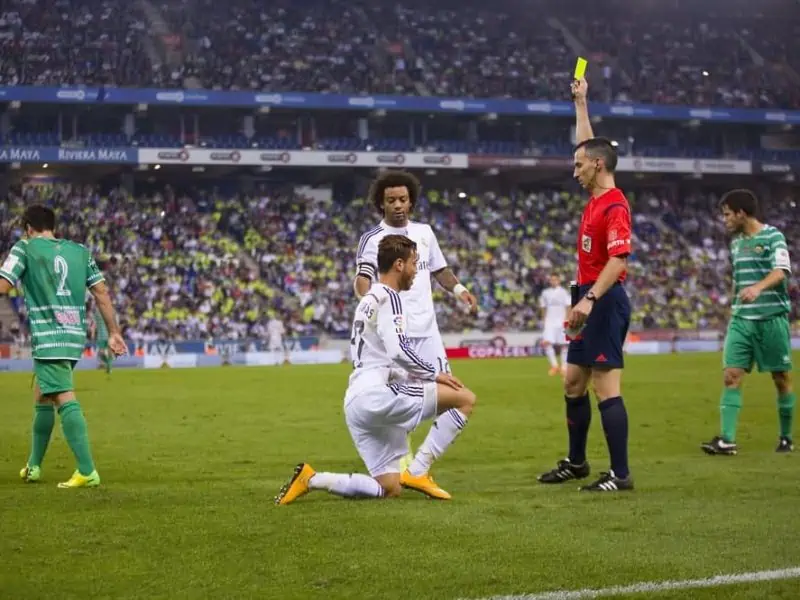
7. Unsporting behavior
In soccer, unsporting behavior is a yellow card offense. Unsporting behavior can be diving to win a penalty or removing your jersey during a celebration.
Both will get you a yellow card in soccer.
But those aren’t the only things that’ll get you a yellow card for unsporting behavior.
When a player removes a jersey;
- A player removing a jersey when celebrating a goal
- The jersey is pulled over the player’s head
- A plyer covers their head with a jersey or mask
For clarification, it is not a yellow card when a player lifts up their jersey just on their front – this could be done in a celebration of wiping their face.
Check out this video for another example:
That’s right! Beware of those dance moves when you’re celebrating.
Yellow Offenses for a substitute or Substituted Player
- Unsporting behavior
- Dissent by word or action
- Delaying play
Other Offences for a Yellow Card
- If a player changes positions with a goalkeeper during the game without notifying the referee.
- A player kicks the ball when leaving the field, as an example a substitute or medication.
- Verbally distracting a player during play or a set-piece.
- Showing a lack of respect for the game, opponent, and referee.
- Marking the field of play, where there should be none officially.
Related Yellow Card Questions
How long is a player suspended after two yellow cards?
A player shown two yellow cards during a match will be sent off during that game. The player will not be able to play in the next match. Further suspensions can be given if the player has accumulated several cards.
Does a yellow card expire?
For league matches, yellow cards will be reset halfway through the season. Cup competitions each have different rules.
What happens if a soccer player gets two yellow cards?
A player shown two yellow cards during a match will be sent off during that game. The player will not be able to play in the next match. Further suspensions can be given if the player has accumulated several cards.
Joel is a seasoned soccer journalist and analyst with many years of experience in the field. Joel specializes in game analysis, player profiles, transfer news, and has a keen eye for the tactical nuances of the game. He played at various levels in the game and coached teams - he is happy to share his insight with you.



